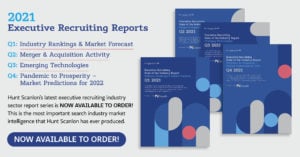Top HR Leaders Share Transitioning Success Factors

February 1, 2021 – Russell Reynolds Associates recently hosted two virtual panel events with more than 200 HR leaders to discuss the success factors when transitioning into new roles. Below are key insights from nine CHRO panelists who have been in their new roles for 12 to 18 months, along with their advice for HR leaders considering their next move.
Understand the business: Several CHROs talked about the need to learn about a new industry, ownership structure or work culture, and reading annual reports, engagement surveys, and any available presentations or data. Even internally appointed CHROs mentioned the need to broaden their understanding of various business units or regions, according to the Russell Reynolds report.
Understand the context: “Read as much research as possible and have early conversations with the board, CEO, C-suite and your predecessor/incumbent,” the report said. “Understand where they are coming from and don’t be afraid to ask questions, as their answers will help you chart a strategy that reflects collective goals.” One CHRO highlighted the importance of asking questions to the chief administrative officer, who oversaw HR before she joined. Another talked about the need to do some homework on the board and management’s role in governance, so they could work effectively with leadership once in the role.
Leverage your network: Speak to industry experts, or HR leaders who have been in similar roles. Have a network you can trust and tap on, and mentors who can advise you.
The First 90 Days
Engage the board: Several CHROs talked about the need to understand board dynamics, priorities, areas of accountability and their vision for the CHRO mandate. It was noted that having early discussions with the board chair on how they saw the CEO-CHRO relationship was very helpful.
Relationships
Get the CEO relationship right: “Choose your boss” was a frequent comment. Many of the Russell Reynolds panel also mentioned the need to balance board engagement carefully with the CEO-CHRO partnership, and to build a high-trust relationship with the CEO. One CHRO said that not being co-located with the CEO added an additional layer of complication which further highlighted the need for trust and collaboration.
Establish relationships with peers: One CHRO shared that peer dynamics are as critical as CEO or board dynamics. Suggestions to build peer relationships included conducting site visits to understand pain points and having offsites for the executive leadership team. This helped new CHROs gain trust to garner some quick wins, but also honor the past in cases where the organization was not ready for change.
Continue to leverage your network: Panelists recommended finding HR leaders in your network who are wise about managing the board, or identifying someone who knows members of your board, understands your business, or your unique company situation (e.g. CEO transition, PE-backed ownership, turnaround, etc.).
Impact
Be intentional about structuring your role: One CHRO mapped out what her role should look like, and then identified areas where she did and did not have experience. Another talked about the importance of self-awareness and knowing where you have skill gaps. Another took a different approach and aligned with leaders on what success looked like a year out and worked backwards from there. In terms of the more technical aspects of HR, several CHROs brought up the need for a better understanding of executive compensation. Overall, the Russell Reynolds panel stressed the need to move beyond the job description and instead focus on what to achieve at transition milestones.
 HR Leadership Lessons From the Early Days of the Pandemic
HR Leadership Lessons From the Early Days of the Pandemic
The world is both united and divided during the COVID-19 pandemic. It’s united in the sense of we are all adjusting to a “new normal” and the challenges—and some opportunities—that arise with a different way of living and working against the backdrop of genuine solidarity.
The division comes in where nations fall in the crisis bell curve—and how we have responded to the situation. In more than 30 virtual gatherings between February and March of this year, Egon Zehnder reached out to hundreds of human resources leaders to learn how they were readying their function and their organizations for the coronavirus crisis and for what is to come.
Identify what needs to change vs. stay the same: One CHRO suggested keeping a running list of things that do not make sense in early conversations, so you can revisit it and see what needs to be changed when you feel ready to do so.
Learn more and do less: Several CHROs talked about the need to listen and learn, and not make big decisions in the first 90 days. They stressed that leaders should not cave into pressure to make decisions early. Instead, they should identify pain points for some quick wins and hold their ground when pushed to make sweeping changes in the early days.
Reputation
Decide what you want to be known for: “Figure out your personal brand and establish some ground rules for your transition both in communication and action,” the Russell Reynolds report said. “If you don’t set the narrative, then someone else will.” One CHRO spoke about the need to be authentic as she was hired because she was different.
Related: How to Leverage Talent Assessment & Development in Uncertain Times
Be prepared for a crisis and harness it: One healthcare CHRO told Russell Reynolds about her 100-day plan but noted that COVID-19 hit within eight weeks of joining. Another created cross-functional taskforces to solve enterprise-level problems and rollout solutions faster. Another CHRO talked about the Black Lives Matter movement in the U.S. and how their company had to respond quickly but thoughtfully.
Resilience
Focus on work-life integration: One CHRO stressed the importance of high-quality sleep, diet and exercise. Another U.K.-based CHRO took her family to visit her company’s headquarters in the U.S., in her third month on the job, so her family could spend time with the CEO in order to understand where and how she spent her time.
 Pandemic Changes CHRO Role for Good
Pandemic Changes CHRO Role for Good
The coronavirus pandemic has revolutionized the role of CHROs at companies everywhere. The crisis has demanded a new set of skills for the position as well as new responsibilities, according to a new report by IMSA Search. To keep their performance at the highest level, however, CHROs must stay focused and be aware of changes in key areas. Here’s the latest.
Pace yourself: Several CHROs highlighted to Russell Reynolds the need to have scalable work practices so you can achieve efficiency and balance and stay in the moment when working day-to-day. Others talked about prioritizing, and not trying to solve everything with the same pace and rigor.
The Next 6-12 Months
Assess your team: Several CHROs talked about honoring the teams they inherited. One CHRO decided to make no new hires for the first six to eight months, while another noted that his first job was to maximize the value of his existing team. The panelists agreed that investing in and advancing their team was important, and swapping people out was the last resort. They were thoughtful about identifying genuine talent needs that filled gaps in their teams’ or their own experience.
Internalize lessons learned: One CHRO shared that his team institutionalized several lessons from the pandemic. His HR organization had become better at connecting people using technology, asking people how they feel, and ensuring that new employees had “water cooler moments” even when boarding or working remotely.
Russell Reynold’s Guide for HR Leaders Considering Next Moves
- Do your homework: Learn about the company, its unique situation, the role, and the CEO and board. Consider whether this is something you see yourself thriving in. For instance, one HR leader might enjoy a “steady state” role while another may thrive in a transformational role. Know your strengths and your career goals.
- Learn through others: Have specialists and trusted advisors around you. Learn through others who have thrived in similar situations to get smart in a short time.
- Choose your boss: Be comfortable with who you are going to work for. Your CEO or direct manager and you should have similar ambitions for the company, work styles that complement each other, and the ability to connect on a human level. If you see a mismatch in values or are concerned about how they will position your role, reconsider the move.
- Build a breadth of experience: Expect to use every tool in your toolbox and know that no experience goes to waste.
- Expect a learning curve: You are signing up to move away from something you are highly successful at, to something that will put you to the test again. Assess your appetite and motivation to go through this process.
Related: Conducting Executive Searches During a Pandemic
Contributed by Scott A. Scanlon, Editor-in-Chief; Dale M. Zupsansky, Managing Editor; and Stephen Sawicki, Managing Editor – Hunt Scanlon Media












